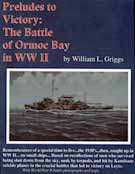Preludes To Victory
The Battle of Ormoc Bay in WWII
"My attention
was focused on avoiding attacks from aircraft, possible torpedoes, enemy fire
from surface ships and shore batteries... We were in a hot spot, hotter than we
knew at the time." - Cmdr Foster, USS MOALE recalling Battle of
Ormoc Bay
Part personal memoir, part a destroy unit history
and part collective oral history, this book is full of photographs, and even poetry.
Preludes to Victory is a superb read, that begins with the author's high school
and college years, while war clouds built. One truly gets a feeling about what
it was like to be living in an America that choose to ignore the raging war in
Europe and the threat of Japan.
USS KEPHART
After
Pearl Harbor, we follow author William Griggs service in the Naval Reserves, which
trained him as a sonar man, 3rd class. His first duty was on a convoy patrol in
early 1944 across the Atlantic to the Mediterranean in USS Kephart DE-207 the crew drilled and trained continuously on the patrol. Although the ship
did not experience enemy action, there was a sonar contact.
The
book is filled with interesting details, like the fact that when the destroy departed
for its first sea trials, there was a large sign placed on the pier that read:
"Constriction of this ship made possible by the purchase of over $5 million
in War Bonds by the citizens of Greensboro, NC" Or, how crew members were
told not to keep diaries, in case the ship was torpedoed and they fell into enemy
hands. And details about life aboard a destroy, from the constant use of off-color
language, to humor to break the monotony.
Converted
to ADP
After these patrols, the ship was repainted to "tropical jungle"
jigsaw pattern and converted to an ADP, the naval designation for a high speed
destroyer transport, complete with LCVP landing boats, and quarters for 150 troops.
Their destination was the Philippines for the Leyte invasion. Many of the troops
and crew were in their upper teens or early twenties.
Battle
of Ormoc Bay
The combat career of KEPHART and her crew began with the Battle
of Ormoc Bay which coincidentally took place December 7, 1944 three years after
Pear Harbor. The book becomes a free wheeling oral history at this point, jumping
from different veterans recollections about the confusion that took place during
the night. Cmdr Foster of the MOALE summarized it best with "My attention
was focused on avoiding attacks from aircraft, possible torpedoes, enemy fire
from surface ships and shore batteries... We were in a hot spot, hotter than we
knew at the time."
Strange Coincidences
Fellow
destroy USS Ward APD-16, the ship that had destroyed a Japanese midget submarine trying
to enter Pear Harbor just prior to the air attack, was herself hit by kamikaze,
one hit the ship and its engine went completely through the ship. Other ships
came to her aid, but the order came for the O'BRIAN to sink her, who captain ironically
was the skipper on WARD at Pearl Harbor!
Relentless
Kamikaze Attacks
At Ormoc, Kamikazes attacked in waves as well as conventional air attacks.
The Japanese had localized air supremacy, although P-38 and other Allied
planes did their best to provide cover. Dodge Priest remembers,"We
would go to chow... but each time we tried GQ alarm would sound. So
the cooks served us coffee and spam sandwiches at GQ stations."
Stories of harrowing combat, near misses and tragic losses. Accounts
of how gunners could see the faces of the youthful Japanese suicide
pilots moments before they crashed into their ship or nearby water.
The damage was so bad, that news that the damage was inflicted by suicide
planes was repressed.
Luzon, Borneo
and (almost) Japan
The book does not end with Ormoc Bay. The KEPHART went
on to participate in the landing at Lingayen Gulf, Luzon and to Borneo to land
Australian troops. When the atomic bomb was dropped and the war ended USS Kephart DE-207 and her crew were training for the invasion of Japan, which all expected would
be the worst operation yet , with even more determined suicide attacks in the
air and on the ground.
This marvelous veteran authored
book now has an honored place on my bookshelf. To order, visit the Battle
of Ormoc Bay Website (via WayBack Machine February 2, 2006) and follow up by making a check for $21.95 payable to W. L. Griggs The book
can be ordered directly by mail from BG Enterprises.
Review by Justin Taylan
Return to Book Reviews | Add a review or submit for review
|
